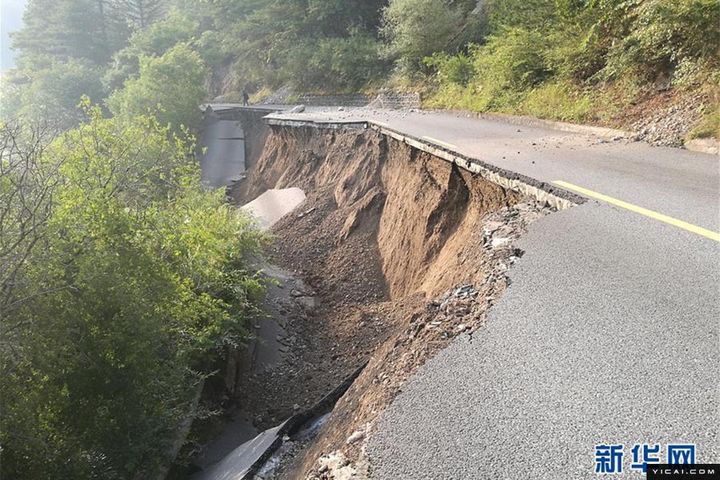 Sichuan Earthquake Administration Denies Jiuzhaigou Quake Link to 2008 Sichuan Disaster
Sichuan Earthquake Administration Denies Jiuzhaigou Quake Link to 2008 Sichuan Disaster(Yicai Global) Aug. 9 -- No link exists between Tuesday's Jiuzhaigou quake and the massive quake of 2008 with its epicenter in Wenchuan, Sichuan province which killed 70,000 people, asserted Zhu Hang, a researcher with the province's earthquake administration.
The Jiuzhaigou and the Xinjiang quakes were unrelated as both areas sit on discrete tectonic plates separate from the area under the 2008 Sichuan disaster, Zhu said in an exclusive interview with Yicai Global this morning.
A 2010 study has fixed the Chinese media focus on the relationship between the Three Gorges Dam, yesterday's Sichuan earthquake and this morning's temblor in Jinghe county in the Xinjiang Uygur Autonomous Region.
The Sichuan quake struck an area that includes the popular Jiuzhaigou National Park and the Three Gorges Dam. Since the dam project began, seismic activity has increased by over 30 percent, unleashing some 3,000 earthquakes and numerous landslides, the study found.
The death toll from the 7.0-magnitude earthquake that struck a remote area in southwest China's Sichuan province last night has risen to 13. As of 9.30 a.m. today, the earthquake has also left 175 people injured, per the provincial government information office. Much scrutiny and scientific study into a link between the earthquake and the dam has ensued since the 2008 Sichuan disaster, but official research bodies have sought to refute all that have returned unfavorable findings.
However, a 2010 study by seismologists at the China Earthquake Administration -- a government body -- confirmed the massive Three Gorges Dam on the Yangtze River has "significantly increased" seismic activity along the dam's reservoir.
The study and seismic monitors around the reservoir and neighboring Hubei province registered 3,429 earthquakes between June 2003, when inundation of the reservoir began, and December 31, 2009.
The longest stretch of the 6,280-kilometer Yangtze River -- the longest waterway in Asia and the third-longest in the world -- is the one that bisects Sichuan and Hubei provinces.
Another study conducted in 2010 recently obtained by Toronto-based environmental and economic think tank Probe International supports Chinese press reports and anecdotal evidence from Chinese living near the Three Gorges Dam, and helps to explain the many landslides that have wreaked havoc in the region and forced the evacuation of 300,000 locals. Parts of the study in Probe International's possession had earlier appeared in a Chinese journal.
According to the Chinese study, which Probe International scientists have translated reads "This represents a 30-fold increase in frequency over the pre-dam period," said Patricia Adams, Probe International's executive director and English editor of the translated study. "The earthquake activity especially increases when the dam operators rapidly increase or decrease the level of water in the reservoir."
Most of the quakes came in under 2.9 magnitude on the Richter scale, classifying them as 'micro-seismic' tremors. One earthquake reached a magnitude of 4.1. It occurred as dam officials attempted to fill the reservoir to its maximum height of 175 meters above sea level.
"Strong earthquakes may occur in the future as the reservoir fills because the microfractures, caused by the large number of microearthquakes, could make the area dangerously prone to a strong earthquake," warned Fan Xiao, chief engineer of Sichuan's geology and minerals bureau.
Large reservoirs are known to trigger earthquakes in a phenomenon called Reservoir-Induced Seismicity (RIS). In a report on 19 dams in China that have suffered from RIS, 15 have geological conditions like the Three Gorges Dam.
Interest in RIS has grown since geoscientists began suggesting that the Zipingpu Dam in Sichuan may have triggered the deadly 2008 earthquake that killed close to 90,000 people. Researchers and citizens alike are now alert to the risk of the Three Gorges -- the world's largest dam -- triggering an earthquake that could topple buildings. In a worst-case scenario, an earthquake could also damage the dam itself, with catastrophic consequences for the millions of people who live downstream.
China's authorities have long dismissed such concerns, saying that a low-level seismic response to filling the reservoir is to be expected. Because the Three Gorges area is only moderately seismically-active, the largest earthquake that might occur would not cause any harm, they claim.